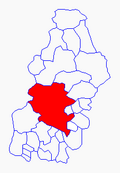Tegucigalpa
Tegucigalpa is the capital and largest city of Honduras. With a total population of 1,526,660 people as of 2022.
City | |
| Tegucigalpa, Municipio del Distrito Central | |
 | |
|
| |
 Location of the Central District within the Department of Francisco Morazán | |
| Coordinates: 14°6′N 87°13′W / 14.100°N 87.217°WCoordinates: 14°6′N 87°13′W / 14.100°N 87.217°W | |
| Country | Honduras |
| Department | Francisco Morazán |
| Municipality | Central District |
| Founded | 29 September 1578 |
| Capital | 30 October 1880 |
| Merged as Central District | 30 January 1937 |
| Government | |
| • Type | Mayor-Council |
| • Body | Municipal Corporation |
| • Mayor | Jorge Aldana (LIBRE) |
| • Vice Mayor | Juan García[3] |
| • Aldermen | 10
|
| Area | |
| • City | 201.5 km2 (77.8 sq mi) |
| • Central District | 1,396.5 km2 (539.2 sq mi) |
| Elevation | 990 m (3,250 ft) |
| Population (2022) | |
| • City | 1,526,660 |
| • Density | 5,604.6/km2 (14,516/sq mi) |
| • Metro | 1,324,000 |
| • Metro density | 948.08/km2 (2,455.5/sq mi) |
| • Demonym | Spanish:tegucigalpense comayagüelense capitalino(a) |
| Time zone | UTC-6 (Central America) |
| Postal code | |
| Annual budget (2008) | 1.555 billion lempiras (US$82,190,000) |
| Climate | Aw |
| Website | Government of Tegucigalpa |
Geography
Tegucigalpa is located on a chain of mountains with elevations of 975 metres (3,199 ft) at its lowest points and 1,463 metres (4,800 ft) at its highest suburban areas. Like most of the interior highlands of Honduras, the majority of Tegucigalpa's current area was occupied by open woodland. The area surrounding the city continues to be open woodland supporting pine forest interspersed with some oak, scrub, and grassy clearings as well as needle leaf evergreen and broadleaf deciduous forest.
Climate
Tegucigalpa has a tropical savanna climate (Köppen: Aw); the west part of the city has a very slight monsoon humid subtropical climate (Köppen: Cwa) influence, milder due to the elevation and with two distinct seasons: the rainy season, and the dry season.[6]
| Climate data for Tegucigalpa (Tegucigalpa Airport) 1961–2022 | |||||||||||||
|---|---|---|---|---|---|---|---|---|---|---|---|---|---|
| Month | Jan | Feb | Mar | Apr | May | Jun | Jul | Aug | Sep | Oct | Nov | Dec | Year |
| Record high °C (°F) | 33.0 (91.4) |
34.5 (94.1) |
35.5 (95.9) |
36.6 (97.9) |
36.9 (98.4) |
34.5 (94.1) |
35.9 (96.6) |
36.9 (98.4) |
34.2 (93.6) |
34.8 (94.6) |
32.8 (91) |
31.4 (88.5) |
36.9 (98.4) |
| Average high °C (°F) | 25.7 (78.3) |
27.4 (81.3) |
29.5 (85.1) |
30.2 (86.4) |
30.2 (86.4) |
28.5 (83.3) |
28.5 (83.3) |
28.0 (82.4) |
28.0 (82.4) |
27.0 (80.6) |
26.0 (78.8) |
25.4 (77.7) |
27.87 (82.16) |
| Daily mean °C (°F) | 20.4 (68.7) |
20.4 (68.7) |
22.1 (71.8) |
23.4 (74.1) |
23.6 (74.5) |
22.6 (72.7) |
22.1 (71.8) |
22.4 (72.3) |
22.2 (72) |
21.5 (70.7) |
21.1 (70) |
18.2 (64.8) |
21.67 (71) |
| Average low °C (°F) | 14.3 (57.7) |
14.5 (58.1) |
15.5 (59.9) |
17.1 (62.8) |
18.2 (64.8) |
18.2 (64.8) |
18.0 (64.4) |
18.0 (64.4) |
17.9 (64.2) |
17.6 (63.7) |
16.3 (61.3) |
15.0 (59) |
16.7 (62.1) |
| Record low °C (°F) | 4.5 (40.1) |
7.2 (45) |
4.7 (40.5) |
8.9 (48) |
11.1 (52) |
12.4 (54.3) |
12.6 (54.7) |
12.2 (54) |
11.0 (51.8) |
10.0 (50) |
7.7 (45.9) |
6.8 (44.2) |
4.5 (40.1) |
| Precipitation mm (inches) | 5.3 (0.209) |
4.7 (0.185) |
9.9 (0.39) |
70.9 (2.791) |
143.5 (5.65) |
108.7 (4.28) |
100.3 (3.949) |
101.9 (4.012) |
177.0 (6.969) |
108.9 (4.287) |
59.9 (2.358) |
20.0 (0.787) |
911 (35.866) |
| % Humidity | 71 | 66 | 62 | 60 | 67 | 75 | 74 | 73 | 76 | 78 | 77 | 75 | 71 |
| Avg. precipitation days (≥ 1.0 mm) | 1 | 1 | 1 | 2 | 9 | 12 | 9 | 9 | 13 | 10 | 4 | 2 | 73 |
| Sunshine hours | 220.8 | 229.4 | 268.5 | 242.8 | 216.3 | 171.7 | 192.5 | 204.8 | 183.4 | 200.4 | 199.2 | 212.2 | 2,542.0 |
| Source #1: NOAA[7] | |||||||||||||
| Source #2: Deutscher Wetterdienst (humidity, 1951–1993)[8] Meteo Climat (record highs and lows)[9] | |||||||||||||
References
- ↑ Tiroren (2008). "Meaning of word "Tegus"". tuBabel.com. Retrieved 2011-06-29.
- ↑ "Enjoy your Tegucigalpa Expat Experience". InterNations.org. 2011-05-22. Retrieved 2011-06-29.
- ↑ 3.0 3.1 AMDC (2011-09-10). "Members of the Municipal Corporation". AMDC. Retrieved 2011-09-28.
- ↑ 4.0 4.1 Honducor (2008-05-10). "ZIP Codes for Honduras". Honduras.com. Archived from the original on 2018-12-26. Retrieved 2011-06-29.
- ↑ Hondutel (2009-10-14). "Honduras Country Codes". CallingCodes.org. Archived from the original on 2018-12-26. Retrieved 2010-06-29.
- ↑ Tim Merrill (2010-08-23). "Honduras-Climate". countrystudies.us. Archived from the original on 29 June 2011. Retrieved 2011-07-05.
- ↑ "Tegucigalpa Climate Normals 1961–1990". National Oceanic and Atmospheric Administration. Retrieved January 24, 2016.
- ↑ "Klimatafel von Tegucigalpa (Int. Flugh.) / Honduras" (PDF). Baseline climate means (1961–1990) from stations all over the world (in Deutsch). Deutscher Wetterdienst. Archived (PDF) from the original on 2 September 2020. Retrieved January 24, 2016.
- ↑ "Station Tegucigalpa" (in français). Meteo Climat. Retrieved 12 June 2016.
